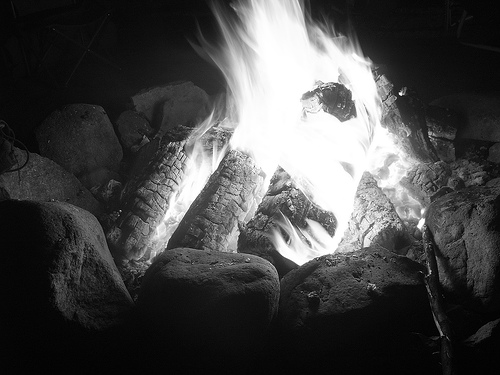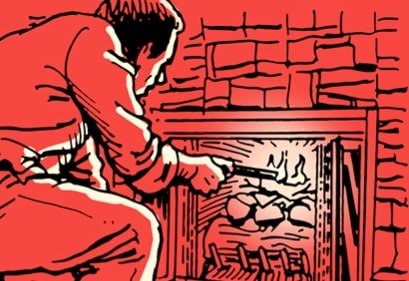
There is a primal link between man and fire. For ancient man, fire provided warmth, protection from wild animals, light in the dark wilderness, and a place to cook food. While fire is no longer vital to most men’s existence, it still has a magnetic power that attracts us. The flames of fire can inspire legendary stories, generate uplifting discussion, and build camaraderie among the men circled around them. Also, there’s nothing more romantic than cuddling up to your gal next to a warm fire. And I’d take some manly campfire-cooked grub over the food of a four-star restaurant any day. Thus every man should know how to start one and be well-practiced in doing so.
1. Create Your Fire Bed
When building a fire, always think about safety first. You don’t want to be that guy who starts a raging wildfire in a national park. If your camping site has a designated fire area, use it. If you’re camping in a more rugged area that lacks fire sites, you’ll need to make your own. Select a site away from trees, bushes, and other plant material. Your fire bed should be on bare earth, not grass (especially dead grass). If you can’t find a bare area, make your own by digging and raking away plant material, taking particular care in clearing away all dry plant material. Dry grass, branches, and bark catch fire easily.
After you’ve cleared the area, it’s time to make your bed. Gather in dirt and place it in the center of your cleared area. Form the dirt into a “platform” that’s about 3-4 inches thick.
2. Time to Gather Your Wood
You’ll need three basics types of materials to build your roaring campfire: tinder, kindling, and fuel wood.
Tinder. Every good campfire starts with good tinder. Tinder catches fire easily, but burns fast. Material like dry leaves, dry bark, wood shavings, dry grass, and some fluffy fungi make for good tinder. If you’re a smart camper, you’ll bring your own tinder in the form of dryer lint or homemade char cloth. Bringing your own tinder is especially important when everything outside is wet. Believe it or not, wet tinder does not catch on fire.
Kindling. Tinder burns fast, so you’ll need something with more substance to keep your flame going. You can’t move directly to big logs. You’ll just smother your little flame. That’s where kindling comes in. Kindling usually consists of small twigs and branches. Go for something that’s about the width of a pencil. Like tinder, kindling needs to be dry or else it won’t burn as easily. If all you have are wet twigs and branches, try whittling away the damp bark with your pocket knife.
Fuel wood. Fuel wood is what keeps your fire hot and burning. Contrary to popular belief, fuel wood doesn’t have to look like the huge logs you use in a fireplace. If you go too big, it’s going to take a long time for the wood to catch fire. Look for branches that are about as wide as your wrist or your forearm.
General tips. When gathering wood for a fire, collect wood that snaps and breaks easily. Dry wood burns the best. If your wood bends, it’s too wet or “green.” If your try to make a fire with this sort of wood, you’ll just get a lot of smoke. Unlike tinder and kindling, fuel wood can be a little damp. The fire will dry it out, but it’s still not ideal.
Collect twice as much tinder, kindling, and fuel wood as you think you’ll need. You’ll be surprised how fast you’ll go through tinder and kindling when you’re starting your fire.
3. Lay Your Fire
There are several ways to lay your fire. Here are three of the most common types of lays.
Teepee Fire Lay
- Place your tinder bundle in the middle of your campfire site.
- Above your tinder bundle, form a teepee with some kindling. Leave an opening in your teepee on the side the wind is blowing against. This will ensure that your fire gets the air it needs and will blow the flames onto the kindling.
- Continue adding kindling to the teepee, working your way up to pencil sized twigs.
- Create a larger teepee structure around your kindling teepee with your fuel wood.
- Place a match under your tinder. Because this lay directs the flame up, the flame should rise to the kindling and then on to the fuel wood.
- The teepee structure will eventually fall, and at this point you can simply add some fuel logs to the fire.
Lean-to Fire Lay
- Stick a long piece of kindling into the ground at about a 30-degree angle. The end of the stick should be pointing into the wind.
- Place a tinder bundle underneath the support stick.
- Place some small pieces of kindling around your tinder nest.
- Lay small pieces of kindling against the piece stuck in the ground. Add another layer with larger pieces of kindling.
- Light the tinder, and watch it burn.
Log Cabin Fire Lay
- Start off by creating a small teepee lay.
- Have you played with Lincoln Logs? Basically, you’re going to play a larger version of Lincoln Logs and burn them when you’re done.
- Get large pieces of fuel wood and place them on opposite sides of the tepee.
- Find smaller pieces of fuel wood and lay them across the first set of fuel wood, parallel on the other sides of the tepee. Just like you would with Lincoln Logs.
- Repeat laying smaller and shorter pieces to form a cabin or pyramid shape.
- Light this baby up.
4. Putting Out Your Fire
So you’re done with your fire. Unless you want to break Smokey the Bear’s heart, you need to put it out thoroughly. The following guidelines will kill your fire good and dead.
Start early. Putting out a fire completely takes longer than you think. Plan when you’re going to bed or leaving and start putting out your fire about 20 minutes before then.
Sprinkle, don’t pour. You should have a bucketful of water near your campfire for safety reasons. When it’s time to go, this will serve as your fire extinguisher. Avoid the impulse to pour all the water on the fire. You don’t want to flood the pit because you or someone else will need to use it later. Instead, sprinkle as much water as you need to put out the embers and charcoal.
Stir. As you sprinkle water over the embers, stir them with a stick or shovel. This ensures that all the ashes get wet. When you don’t see any steam and don’t hear any hissing noises, you know you’re getting close to a completely extinguished fire.
Touch test. Don’t actually run your hands through the ashes. You don’t want to brand yourself with a searing ember. Put the back of your hand near the ashes. If you still feel heat, it’s too hot to leave. Keep adding water and stirring. As soon as it feels cool, you’re good to go.
Dispose the ashes. You don’t want to leave the next camper a fire bed full of old ashes. Also, if you had to create your own fire bed, you want to leave the land in the same condition as how you found it. Scoop up the ashes in a bag and spread them out around the campsite.
Patch up your ground. If you made your own fire bed, replace the dirt and sod you dug up.
For information on how to start a fire sans matches, check out 9 Ways to Start a Fire Without Matches.
Check out our other resources on building a fire:







